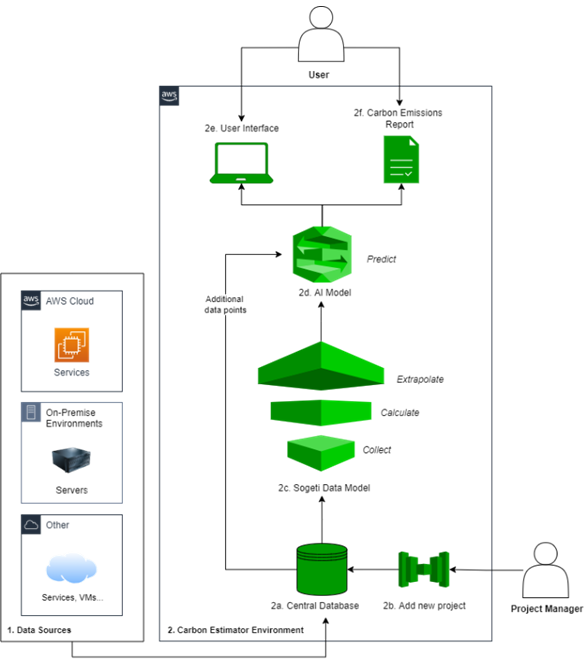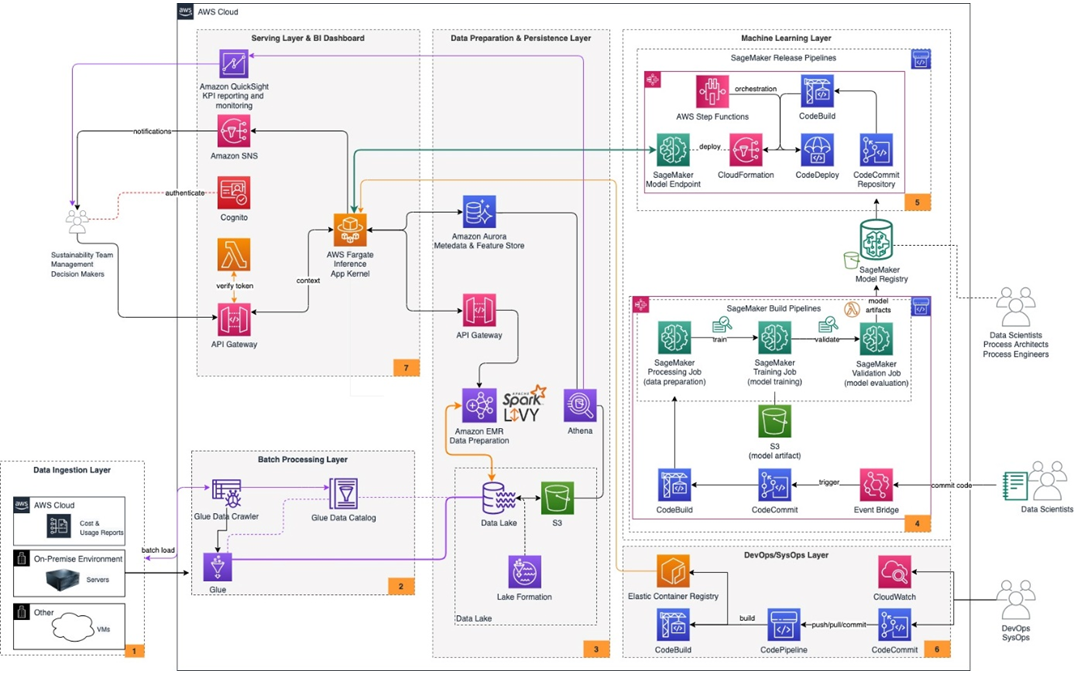Empowering Sustainability with Carbon Estimator by Sogeti
Dangerously high, above normal temperatures in the United States...
The UK’s hottest day on record. Forest fires sweeping parts of Europe. These events demonstrate the impact of climate change is very real. As Capgemini Group CEO Aiman Ezzat voiced at the 2021 World Climate Summit, “What we need today is nothing short of a (climate) revolution.”
Organizations in both public and private sectors can play a huge role in that revolution by embedding sustainable actions and social responsibility in their business models. The good news is that many are well on the way to achieving this goal, having set carbon neutrality and net zero actions that are integrated into their sustainable IT strategies.
In line with Capgemini Group‘s sustainability vision to become a net zero business by 2040, Sogeti has collaborated with Amazon Web Services (AWS) to find a pragmatic solution that is helping to bring this vision to life—it’s called Carbon Estimator by Sogeti (CES).
Check out the full blog on AWS.
This tool can be used to automatically bring insights into the carbon footprint of any cloud component used to serve technology, including complex artificial intelligence (AI) solutions enabled by MLOps services in the cloud. CES highlights the goal of many cloud providers and businesses—to unlock the value of cloud sustainably.
Capgemini is an AWS Premier Tier Services Partner and Managed Cloud Service Provider (MSP) with a multicultural team of 340,000 people in nearly 55 countries.
A Tradition of Sustainable IT
The Capgemini Group’s sustainability vision is to become a net zero business by 2040, a commitment underpinned by deep carbon reduction targets which were validated by the Science Based Targets initiative. This vision is being delivered through Capgemini’s net zero program.
Part of the Group’s transition involves embedding sustainability into the services it provides clients through a sustainability framework and sustainable IT model. These highlight that there is a distinction between two types of IT activities: “reduction of the bad” and “provisioning for the good.” From an IT perspective, organizations can either focus on a sustainable business through the utilization of IT technologies, or sustainable IT by refining their IT strategy with a sustainable lens.
Within the Capgemini Group, there are a number of examples on how to apply IT to form sustainable businesses. Capgemini has developed an intelligent data solution to identify sperm whales using computer vision, thus enabling the identification of migration routes, social structures of whale groups, and their natural habitats.
Capgemini has also collaborated with AWS on some offerings for sustainable healthcare such as simplified pandemic management. Finally, the Geoforest and Georice solutions are a collaboration between Capgemini, NASA, and European Space Agency (ESA) where satellite images are used to monitor the spread of deforestation, urbanization, or the state of the oceans and crops.
Sustainability-focused innovation continues at Sogeti, which is working with enterprise customers to bring sustainable IT solutions to the fore. Sogeti created automated mechanisms enabling a retail customer to turn applications on/off based on their application needs, reducing consumption by more than 55%. Additionally, the company is benefiting from the cost-saving impact of cutting its carbon emissions.
Sogeti is also transforming a logistics firm’s legacy applications into cloud-native architectures. Instead of large servers running and consuming electricity 24/7, the consumption occurs only when the applications are utilized. This creates a flexible setup for the customer that is useful for reducing their carbon emissions, as well as for the fluctuating nature of the postal sector in which the company operates.
Sustainability in the AWS Cloud
Amazon is deeply committed to sustainability, and one of the ways AWS is building a sustainable business for its customers is by focusing on energy efficiency across all aspects of their infrastructure. Environmental sustainability is a shared responsibility between customers and AWS.
According to a 451 Research report, moving on-premises workloads to AWS can lower your workload carbon footprint by 88%. Furthermore, AWS’s infrastructure is 3.6 times more energy efficient than the median of the surveyed U.S. enterprise data centers. Announced at re:Invent 2021, the AWS customer carbon footprint tool provides clear metrics to customers regarding how much the carbon emissions generated by their applications.
Customers also have a responsibility for sustainability in the cloud—optimizing workloads and resource utilization, and minimizing the total resources required to be deployed for their workloads. Werner Vogels, VP and CTO of Amazon, has said “Don’t forget to turn off the lights.” Customers can easily integrate AWS Auto Scaling to automatically scale up and down resources based on demand. They can pick technologies such as serverless with AWS Lambda to get far greater CPU, memory, and energy utilization.
Putting the Vision into Practice
Carbon Estimator by Sogeti (CES) is a pragmatic enabler for the net zero and carbon neutrality goals of any business. Although the following section focuses on AWS APIs and services, CES can be used on any cloud platform and can include on-premises data for maximized insights.
To help clients to the fullest extent, Sogeti tracks the steps a customer takes when focusing on carbon neutrality. The CES solution focuses on:
- Analysis and insights: CES helps collect, calculate, and extrapolate carbon emissions of cloud infrastructure.
- Prediction: CES predicts the future emission of carbon.
- Reduce: The solution uses an extensive Capgemini Group-wide IT knowledge of the AWS Cloud to refactor applications, streamline processes, and reduce AWS consumption.
- Offset: Partner with industry-recognized parties to provide offset strategies instead of greenwashing strategies.
The product design to support these steps includes the following modules:
Data Sources
- As an integrated cloud solution, CES offers freedom in the choice of the data sources that can be plugged in. For example, if a business uses AWS services to deploy a website and uses a chatbot on that channel deployed on another cloud platform, CES can pick up the necessary data points and calculate the emissions.
- The same applies to on-premises usage mixed in with cloud service usage.
CES Environment
- The data points collected from various data sources are uploaded to the central database. This is important as it unifies disperse data sources into a structured format.
- In the event of a new project, project managers can easily make data available to feed into the data model. This addition relies on data sources in the central database.
- CES’s data model collects relevant data, calculates the variables, and extrapolates the carbon emission. It takes billing and usage information to extrapolate the carbon emissions relying on the open-source Cloud Carbon Footprint calculation, querying billing and usage data stored in an Amazon Simple Storage Service (Amazon S3) bucket using Lambda functions on top of Amazon Athena with the end goal of calculating the carbon emissions.
- A predictor in the form of a machine learning (ML) algorithm predicts the carbon footprint of a customer’s cloud and on-premises services. The model is fed with insights from the data model and additional data points (features) stored in the central database. The predictor relies on algorithms such as Classification and Linear Regression, forecasting the upcoming costs prepares the business for a surge in emissions.
- Unified dashboard that visualizes the results in a user interface (UI) or dashboard such as Amazon QuickSight.
- Mechanism to automatically create carbon emission reports for quick sharing with relevant team members and for use in reporting.

The architecture is modular in nature, so businesses can use CES as a calculator, or simply as a reporting tool if they do not need a user interface (UI) or dashboard.
The CES is a good example of using AI for sustainability. At the same time, it’s important to highlight the duality of using AI to empower sustainability goals. This duality reflects itself in the carbon-intense nature of training and deploying AI in production.
To make sure the AI is as efficient and scalable as possible, all development is carried out in the cloud on services that rely on renewable energy. More importantly, Sogeti relies on MLOps services to reach a fully “green” MLOps solution.
With AWS, Sogeti ensures the AI models are optimized and prescribes high quality and efficient training, deployment, and retraining by utilizing the AWS MLOps framework. This framework is an iterative and repetitive process for evolving AI models over time.

The CES MLOps architecture consists of the following parts:
- Building a data hub by collecting inputs from various sources.
- Implementing a batch data processing layer by leveraging AWS Glue.
- Building the data lake through data preparation, cleansing, extract, transform, load (ETL) jobs, and pipelines using Apache Spark on Amazon EMR and data persistence on Amazon S3.
- Training and tuning machine learning model pipelines using MLOps with Amazon SageMaker.
- Deploying ML model endpoint release pipelines using MLOps with Amazon SageMaker. Any SageMaker projects in the architecture offer templates to quickly provision standardized data scientist environments with well-tested and up-to-date tools and libraries, source control repositories, boilerplate code, and CI/CD pipelines.
- Implementing SysOps and DevOps CI/CD automation pipelines and infrastructure monitoring for governance.
- Building a platform serving layer using ML inference and process orchestration performed with AWS Fargate. Visual analytics are exposed via Amazon QuickSight for the purposes of monitoring.
Conclusion
To “get the future we want,”’ which is Capgemini Group’s brand promise, we need pragmatic and transparent tools to enable carbon neutrality and net zero goals. Carbon Estimator by Sogeti (CES) is one tool to help meet those goals. It’s a modular, unified, and smart solution that helps customers meet their sustainability goals.
Additionally, CES brings together Capgemini’s sustainability vision with that of AWS. Together, the two are bringing sustainable IT solutions to the cloud. CES provides a data model to calculate and estimate the carbon emissions of IT solutions deployed in the cloud—directly enabling businesses to act, reduce, and monitor the carbon footprint of their IT solutions to support their net zero transformatios.
Check out the full blog on AWS.
+31347242046

+31347242046
+31347243420

+31347243420


![[Missing text '/pageicons/altmail' for 'English']](/Static/img/email.png)